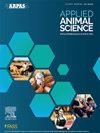将湿酒糟放在地上作为放牧牛的后期蛋白质补充及其对肥育性能和胴体特性的影响
IF 1.5
Q3 AGRICULTURE, DAIRY & ANIMAL SCIENCE
引用次数: 0
摘要
目的大平原西部牧场放牧牛的收益特点是夏末与初夏相比收益较低,因此也可能限制牧场主将放牧牛作为一种缓解干旱的策略,使牲畜种类多样化。我们的目标是测量和比较夏末牲畜在饲喂蛋白质补充剂(在地上或在床上)和未添加蛋白质补充剂的对照后的增益。材料和MethodsEighty引导(初始BW±SD = 267±22公斤/头)储存在8牧场(10引导/牧场)每年5月至10月4 4年。两个复制的治疗方法,包括(1)湿蒸馏器谷物在铺位上,(2)湿蒸馏器谷物美联储在站在地上植被、(3)1:1的混合物米洛:大豆粉在铺位上,和(4)控制治疗的补充,在夏的菜牛放牧试验比较。在生长季的后半期(7月中旬至10月上旬),每周补饲3次,以每头牛0.14 kg/d的速度提供CP。在5月、7月中旬和10月的牧场和饲养场育肥阶段结束时称重。结果与讨论在2011年至2014年的放牧季节后半段,与未添加对照组相比,添加组的动物日增重更高(分别为0.77至0.81 kg/头/天,添加组与未添加组分别为0.70 kg/头/天)。各补充组(包括地面饲养的湿蒸馏器组)在牧草上的收益差异不大。在育肥期,未补饲的动物与补饲的动物相比增重相似(235.9 kg/头vs 229.7 kg/头)。启示和应用在该地区,无论将湿酒糟补充蛋白质,即使是少量的,在大多数年份都有利于牲畜的增重,无论补充物是放在地上还是放在床上。任何残留在土壤上的酒糟添加剂对动物的增重似乎都是无关紧要的。在西部大平原牧场放牧季节后期,缺乏蛋白质补充限制了牲畜的收获。本文章由计算机程序翻译,如有差异,请以英文原文为准。
Using wet distillers grains placed on the ground as a late-season protein supplement for grazing stocker steers and subsequent effects on finishing performance and carcass characteristics
Objective
Stocker cattle gains on western Great Plains rangelands are characterized by lower gains during late summer compared with early summer, and thus may also limit rancher use of stocker cattle to diversify livestock classes as a drought mitigation strategy. Our objective was to measure and compare late-summer stocker cattle gains after feeding a protein supplement (on the ground or in a bunk) to a nonsupplemented control.
Materials and Methods
Eighty steers (initial BW ± SD = 267 ± 22 kg/head) were stocked on 8 pastures (10 steers/pasture) each year from May to October for 4 yr. Two replications of 4 treatments, including (1) wet distillers grains fed in a bunk, (2) wet distillers grains fed on the ground on standing vegetation, (3) a 1:1 mixture of milo: soybean meal fed in a bunk, and (4) a control treatment of no supplement, were compared during a late-summer stocker steer grazing trial. Supplements were fed 3 times per week to supply CP at 0.14 kg/d per steer during the last half (77 d) of the growing season, mid-July to early October. Steers were weighed in May, mid-July, and October on pasture, and at the end of a feedlot finishing phase.
Results and Discussion
During the last half of the grazing season in 2011 to 2014, animal daily gains were greater for supplemented groups compared with the nonsupplemented control group (0.77 to 0.81 kg/head per day vs. 0.70 kg/head per day, supplemented vs. nonsupplemented, respectively). Gains on pasture from supplemented groups, including the wet distillers group fed on the ground, were not different from each other. Animals not supplemented on pasture had similar gain during the finishing phase in the feedlot compared with animals supplemented on pasture (235.9 kg/head vs. 229.7 kg/head).
Implications and Applications
Late-season protein supplementation with wet distillers grains, even in small quantities, would benefit stocker cattle gain during most years in this region, whether the supplement is placed on the ground or in a bunk. Any residual amount of distillers supplement that may be remaining on the soil appears to be inconsequential to animal gain. Lack of protein supplement limits stocker animal gains during the late grazing season in western Great Plains rangelands.
求助全文
通过发布文献求助,成功后即可免费获取论文全文。
去求助

 求助内容:
求助内容: 应助结果提醒方式:
应助结果提醒方式:


